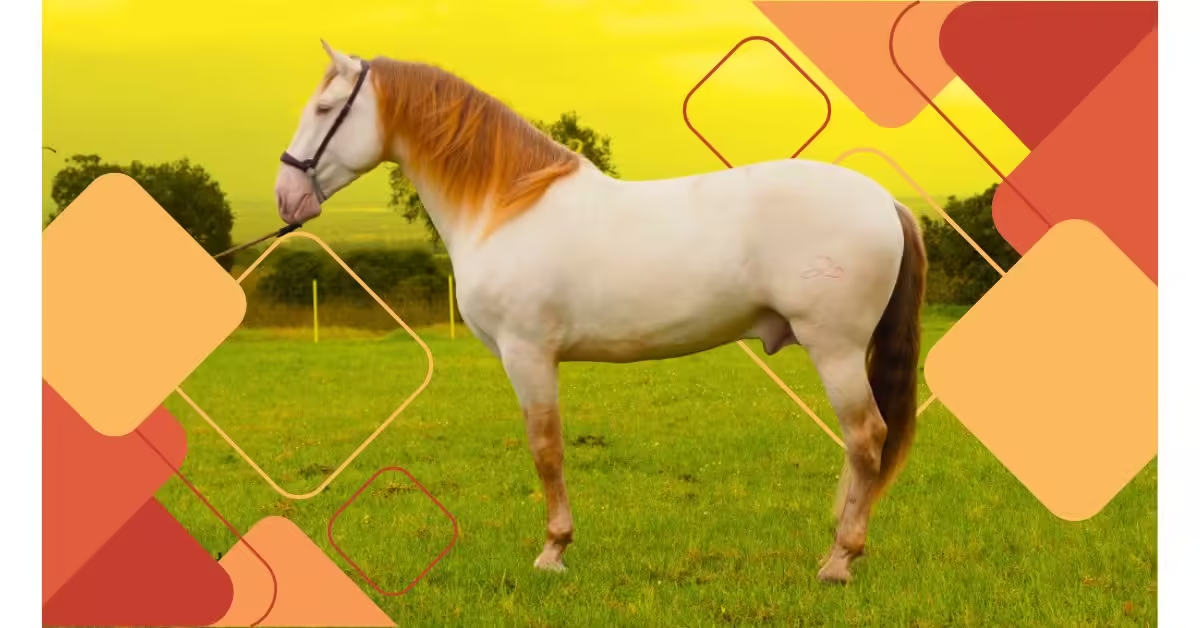Perlino horses are known for their striking beauty, characterized by a unique coat color and blue eyes that set them apart from other horse breeds. With their light-colored coat, these horses have captivated equestrian enthusiasts around the world. However, there is more to these horses than just their appearance. From their genetics to their temperament, Perlino horses offer a fascinating glimpse into equine diversity. In this comprehensive guide, we’ll explore the most important things to know about Perlino horses, from their genetics to their care.
1. What Is a Perlino Horse? Understanding the Unique Coat Color
A Perlino horse is a horse with a cream-colored coat, blue eyes, and often a pinkish or tan hue around the nose and eyes. Perlino horses are part of the diluted color category, which includes horses like buckskins and cremellos. Their unique coloring comes from the creme gene, which affects the coat’s pigmentation.
While many people mistake Perlino horses for albino, they are not albino at all. Their light cream color is the result of a genetic dilution of a bay horse, which causes their distinctive look. This specific dilution creates a light body color with a hint of a reddish or tan tint, often on their mane and tail.
2. Perlino Horse Genetics: How Their Coat Color Is Created
The Perlino horse’s coat color is the result of a specific genetic combination. Perlino horses are born when a bay horse inherits two copies of the cream dilution gene. The cream gene, also known as Cr, is responsible for diluting the original color of the bay coat, resulting in the light cream color.
Here’s how the genetic process works:
- Bay base color: A Perlino horse starts with a bay base coat color, which is a combination of black points (mane, tail, and legs) and a reddish-brown body.
- Cream dilution: When a bay horse inherits two copies of the cream gene, the body’s red pigment is diluted into a cream color, while the black points are lightened to a slightly reddish hue.
This genetic combination also gives the Perlino horse its blue eyes, which are characteristic of horses with the double cream dilution. The Perlino color is unique to horses that carry this double dilution, differentiating them from other light-colored horses like buckskins or cremellos.
3. Perlino vs Cremello: What’s the Difference?
While Perlino horses and Cremello horses may look similar, they are genetically different, and their coat colors reflect this difference. Here’s how to distinguish between the two:
- Perlino Horses: As mentioned earlier, Perlino horses are the result of a bay horse that has inherited two copies of the cream gene. Their coat is cream-colored, but they often have reddish or tan points in their mane and tail. They also have pink skin and blue eyes.
- Cremello Horses: Cremello horses are the result of a chestnut base color that has been diluted twice by the cream gene. Their coat is more uniformly pale, often appearing almost white, and they have pink skin with light blue eyes.
The key difference lies in the base color—while Perlino horses have a bay base, Cremello horses start as chestnuts. The double cream dilution affects these base colors differently, resulting in subtle differences in their coat hues and pigmentation.
4. Temperament and Behavior of Perlino Horses
Like most horses that carry the cream gene, Perlino horses are known for their gentle temperament and friendly demeanor. Although the coat color doesn’t necessarily affect behavior, many Perlino horses share common traits:
- Calm and Trainable: Perlino horses are often described as calm and trainable, making them ideal for riders of all levels. Whether you’re a beginner or experienced, their friendly nature makes them easy to handle.
- Intelligent: These horses are known for their intelligence, making them quick learners during training. Their adaptability allows them to excel in various equestrian disciplines.
- Good with Children: Due to their patient and gentle nature, Perlino horses are often recommended for children or novice riders. They are less likely to display aggressive behavior and are usually willing to cooperate with their handlers.
Overall, Perlino horses make excellent companions, both for recreational riding and in competitive settings.
5. How to Care for a Perlino Horse: Tips for Grooming and Health
Taking care of a Perlino horse requires attention to both their grooming needs and general health. Since their light-colored coats are prone to dirt and skin sensitivities, here are some essential tips for proper care:
- Grooming: Perlino horses’ light coats make them more susceptible to dirt, so regular grooming is essential. Brushing their coat daily helps remove dust and keep their skin healthy. Pay special attention to areas around the eyes and muzzle, as their pink skin is more sensitive to the sun.
- Sun Protection: Due to their light pigmentation and pink skin, Perlino horses are more prone to sunburn. It’s important to provide them with access to shaded areas, and you may want to apply sunscreen to sensitive areas, like their muzzle.
- Diet: A balanced diet of high-quality hay, grain, and essential supplements will keep your Perlino horse healthy. Providing the right nutrients will ensure that their coat remains in top condition and their overall health is maintained.
- Regular Vet Check-ups: As with any horse, Perlino horses should have regular vet check-ups to ensure they remain healthy. This includes dental care, vaccinations, and hoof trimming.
By maintaining a consistent care routine, you can help ensure that your Perlino horse thrives in both health and appearance.
6. Perlino Horses in Horse Shows: Why They Stand Out
Perlino horses often stand out in horse shows because of their striking appearance and unique color. Their cream-colored coats and blue eyes make them eye-catching in any competition. Here’s why Perlino horses shine in the show ring:
- Aesthetic Appeal: Perlino horses’ unique coloration gives them a distinct visual appeal, helping them stand out in shows that focus on conformation or beauty.
- Performance Versatility: Perlino horses can participate in various equestrian events, from dressage to show jumping. Their calm temperament and intelligence make them ideal candidates for a wide range of competitions.
- Rarity Factor: Since Perlino horses are relatively rare compared to other color variations, they tend to attract attention in competitive settings. Judges and spectators alike appreciate their distinctive look.
Whether you’re showing your Perlino horse in local events or more prestigious competitions, their appearance is sure to catch the eye of everyone present.
7. Common Health Concerns in Perlino Horses
While Perlino horses are generally healthy, there are some specific health concerns that owners should be aware of:
- Sun Sensitivity: As previously mentioned, the light coat and pink skin of Perlino horses make them prone to sunburn. Ensuring they have adequate shade and sun protection is critical for preventing skin issues.
- Eye Sensitivity: Perlino horses have light-colored eyes, which can be more sensitive to sunlight than darker-colored horses. It’s important to monitor their eyes for any signs of irritation or discomfort.
- **Skin## Common Health Concerns in Perlino Horses (Continued)
As mentioned, Perlino horses have a few unique health concerns related to their coat and eye color due to the genetics behind their light pigmentation. Here are a few more to be aware of:
- Skin Sensitivity: The pink skin of a Perlino horse is more sensitive to the environment, particularly sun exposure, and may be prone to irritation. In addition to sunburn, Perlino horses may develop skin infections or rashes if not kept in clean, shaded environments.
- Eye Sensitivity: With their light blue eyes, Perlino horses may experience heightened sensitivity to sunlight. This can cause squinting or discomfort in bright environments. Some owners choose to use UV-protective fly masks to shield their horse’s eyes from the sun.
- Melanomas: While not as common in Perlino horses as in gray horses, some Perlino horses may develop melanomas due to their light pigmentation. Regular veterinary check-ups are crucial to monitoring and treating any skin irregularities.
To mitigate these risks, consistent vet care, sun protection, and proper grooming are essential for maintaining the health and comfort of Perlino horses.
Conclusion
Perlino horses are a rare and beautiful breed with striking cream-colored coats and blue eyes. Their distinct appearance, coupled with a gentle temperament and intelligence, makes them a favorite among horse enthusiasts. Understanding their unique genetic makeup, along with their care and health needs, ensures that you can maintain a healthy and happy Perlino horse. From protecting their skin from sunburn to providing the proper grooming and diet, these horses require special attention to thrive.
Whether you’re interested in showing Perlino horses in competitions or enjoying their company as a riding companion, they are truly special animals worth appreciating.
FAQs About Perlino Horses
- What is a Perlino horse?
A Perlino horse is a bay horse that has inherited two copies of the cream dilution gene, resulting in a cream-colored coat with reddish or tan points in their mane and tail, as well as blue eyes. - What is the difference between a Perlino and a Cremello horse?
The key difference is the base color. Perlino horses are derived from bay horses, while Cremellos come from chestnuts. Perlino horses tend to have a slight reddish tint in their mane and tail, whereas Cremellos have an almost white, uniform cream color. - Do Perlino horses have blue eyes?
Yes, Perlino horses typically have light blue eyes due to the effect of the double cream dilution gene on their coat color and pigmentation. - Are Perlino horses rare?
Yes, Perlino horses are considered relatively rare due to the specific genetic combination required to produce their unique coat color. - How should I care for a Perlino horse’s coat?
Perlino horses are prone to sunburn due to their light-colored skin. Regular grooming, sun protection, and access to shaded areas are essential in maintaining their coat and skin health. - Can Perlino horses be shown in competitions?
Yes, Perlino horses can excel in horse shows and are often appreciated for their unique appearance and versatility in various equestrian disciplines. - Are Perlino horses good for beginners?
Due to their calm and gentle nature, Perlino horses are often a good choice for beginners, as they are easy to handle and quick to train. - What is the lifespan of a Perlino horse?
Like most horse breeds, Perlino horses have an average lifespan of 25-30 years, depending on their overall health and care. - Do Perlino horses require special diets?
Perlino horses do not require a special diet beyond what is typically provided to healthy horses—high-quality hay, grains, and appropriate supplements. However, maintaining proper nutrition helps keep their coat healthy. - Why do Perlino horses have pink skin?
The pink skin in Perlino horses results from the cream dilution gene, which reduces the pigmentation in their skin and coat. This is also why they have a greater tendency for sun sensitivity.

Joseph Bush is a seasoned writer and researcher with over 7 years of experience covering a wide range of general topics, from lifestyle and technology to business and current events. He is dedicated to producing fact-checked, reader-friendly content that informs, engages, and empowers readers.
Throughout his career, Joseph has followed strict editorial guidelines, relied on reputable sources, and ensured every article meets the highest standards of accuracy and clarity. His expertise spans multiple fields, allowing him to explain complex topics in a way that’s easy to understand.
Passionate about continuous learning, Joseph stays updated on industry trends and best practices to deliver trustworthy, well-rounded insights. Readers can rely on his work for its credibility, depth, and real-world relevance.




